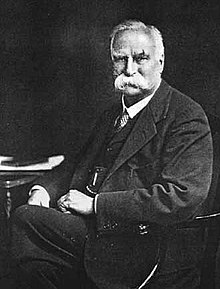Edward Bagnall Poulton
Sir Edward Bagnall Poulton | |
|---|---|
 Sir Edward Bagnall Poulton Photograph by James Lafayette | |
| Born | 27 January 1856 |
| Died | 20 November 1943 (aged 87) |
| Nationality | English |
| Alma mater | Jesus College, Oxford |
| Known for | Aposematism, frequency-dependent selection, camouflage |
| Awards | Linnean Medal (1922) Hope Professor of Zoology |
| Scientific career | |
| Fields | Evolutionary biology |
| Institutions | University of Oxford |
Sir Edward Bagnall Poulton,
Life
Edward Poulton was born in Reading, Berkshire on 27 January 1856, the son of the architect William Ford Poulton and his wife, Georgina Sabrina Bagnall. He was educated at Oakley House School in Reading,[3] which he described as having mainly nonconformist pupils.[1]
Between 1873 and 1876, Poulton studied at
He was knighted by King George V in 1935. Poulton died in Oxford on 20 November 1943.
Career

Poulton was a Darwinist, believing in natural selection as the primary force in evolution. His 1890 book, The Colours of Animals, introduced the concepts of frequency-dependent selection and aposematic coloration, as well as supporting Darwin's then unpopular theories of natural selection and sexual selection.[6] He conducted a range of experiments on the colours of polymorphic caterpillars to examine if food, background or other factors are involved in their colour changes. He was able to show that the caterpillars were sensitive to the background colours and that it was perceived even when they were blinded, and was among the earliest to suggest extraocular photoreception.[7]
Poulton enlarged the Hope entomological collections with his catches in the field which earned him the nickname of "Bag-all" Poulton. Many of the specimens are unmounted and held in biscuit tins.[8]
In his 1896 book Charles Darwin and the Theory of Natural Selection, Poulton described Darwin's On the Origin of Species as "incomparably the greatest work" that the biological sciences had seen. Critics of natural selection, Poulton contended, had not taken the time to understand it.[9]
Poulton, along with

Poulton's Presidential Address to the
Family
Poulton lived with his family at 56
Legacy
Poulton is remembered as an early originator of the
Published works
Poulton had over 200 publications spanning over sixty years.
- 1890. Kegan Paul, London.
- 1896. Charles Darwin and the Theory of Natural Selection. Cassell, London.
- 1904. What is a Species? (Presidential address to the Entomological Society of London, January 1904) Proceedings of the Entomological Society of London, 1903.
- 1908. Essays on Evolution. London, Cassell.
- 1909. Charles Darwin and the Origin of species; addresses, etc., in America and England in the year of the two anniversaries[19]
- 1915. Science and the Great War: The Clarendon Press, Oxford.
Awards and honours
- Fellow of the Royal Society in June 1889.[1][20]
- President of the Linnean Society(1912–1916)
- Royal Society's Darwin Medal in 1914
- Linnean Society's Linnean Medal in 1922.
- Knighted in 1935.[21]
- President of the British Association for the Advancement of Sciencefor 1937.
See also
- Hugh Cott)
References
- ^ .
- ^ "POULTON, Edward Bagnall". Who's Who. Vol. 59. 1907. p. 1421.
- ISBN 0-902-198-84-X. Archived from the original(PDF) on 4 March 2016. Retrieved 14 January 2018.
- ^ Carpenter, G. D. H. "Poulton, Sir Edward Bagnall (1856–1943)". Oxford Dictionary of National Biography (online, free). Oxford University Press. Retrieved 18 July 2007.
- ^ Baker, J.N.L. (1971). Jesus College 1571 – 1971. p. 68.
- ^ Mallet, Jim. "E.B. Poulton (1890)". University College London. Retrieved 23 November 2012.
- .
- ^ Salmon, Michael A. (2000). The Aurelian Legacy. Harley Books. pp. 187–188.
- ^ Poulton, E.B. (1896). Charles Darwin and the Theory of Natural Selection. Cassell.
- ISBN 978-0-8018-4391-4.
- ^ Crew, F. A. E. (1969). "Recollections of the Early Days of the Genetical Society" (PDF). Archived (PDF) from the original on 29 September 2022. Retrieved 23 March 2024.
- JSTOR 24204999.
- ISBN 978-0-14-071045-8.
- required.)
- ^ Poulton E.B. 1904. What is a species? (Presidential address to the Entomological Society of London) 'Proceedings of the Entomological Society of London (revised version in Poulton E.B. Essays on Evolution. 1889–1907. Clarendon Press, Oxford. pp. 46–94)
- ^ Poulton, E.B. (1938). "The conception of species as interbreeding communities". Proceedings of the Linnean Society of London. 150 (4): 225–226.
- S2CID 86041887.
- ^ Mayr, Ernst (1942). Systematics and origin of species. New York: Columbia University Press. p. 148.
- S2CID 26879402.
- ^ "Lists of Royal Society Fellows 1660–2007". London: The Royal Society. Archived from the original on 24 March 2010. Retrieved 14 July 2010.
- ^ "No. 34119". The London Gazette (Supplement). 28 December 1934. pp. 1–2.
"No. 34135". The London Gazette. 22 February 1935. p. 1269.

